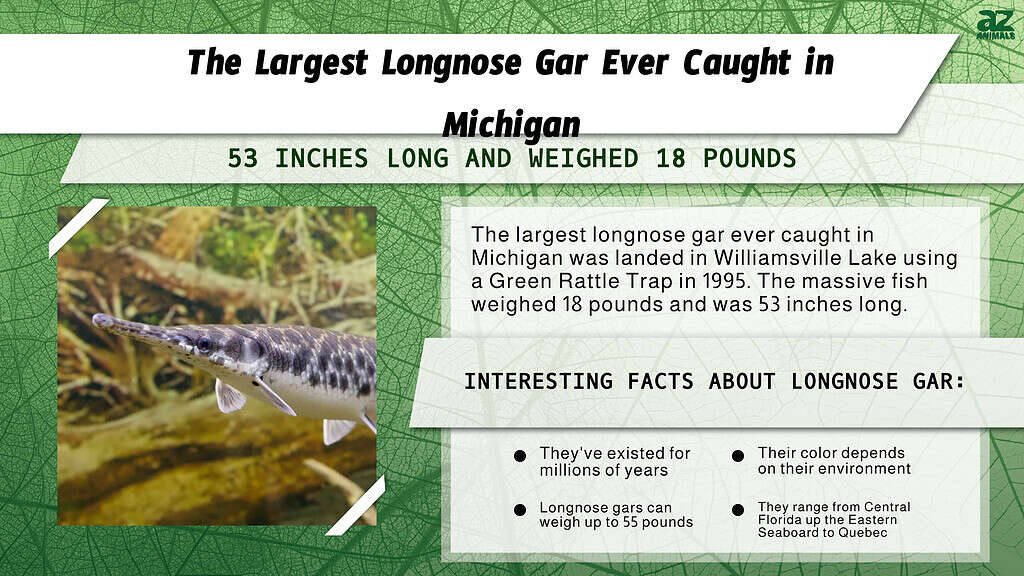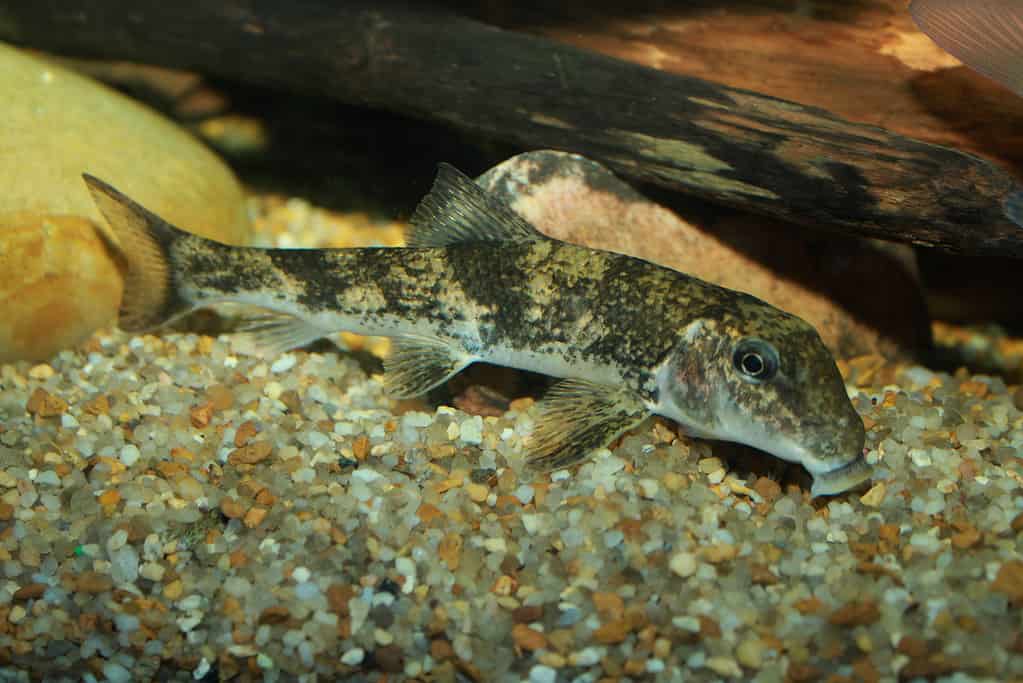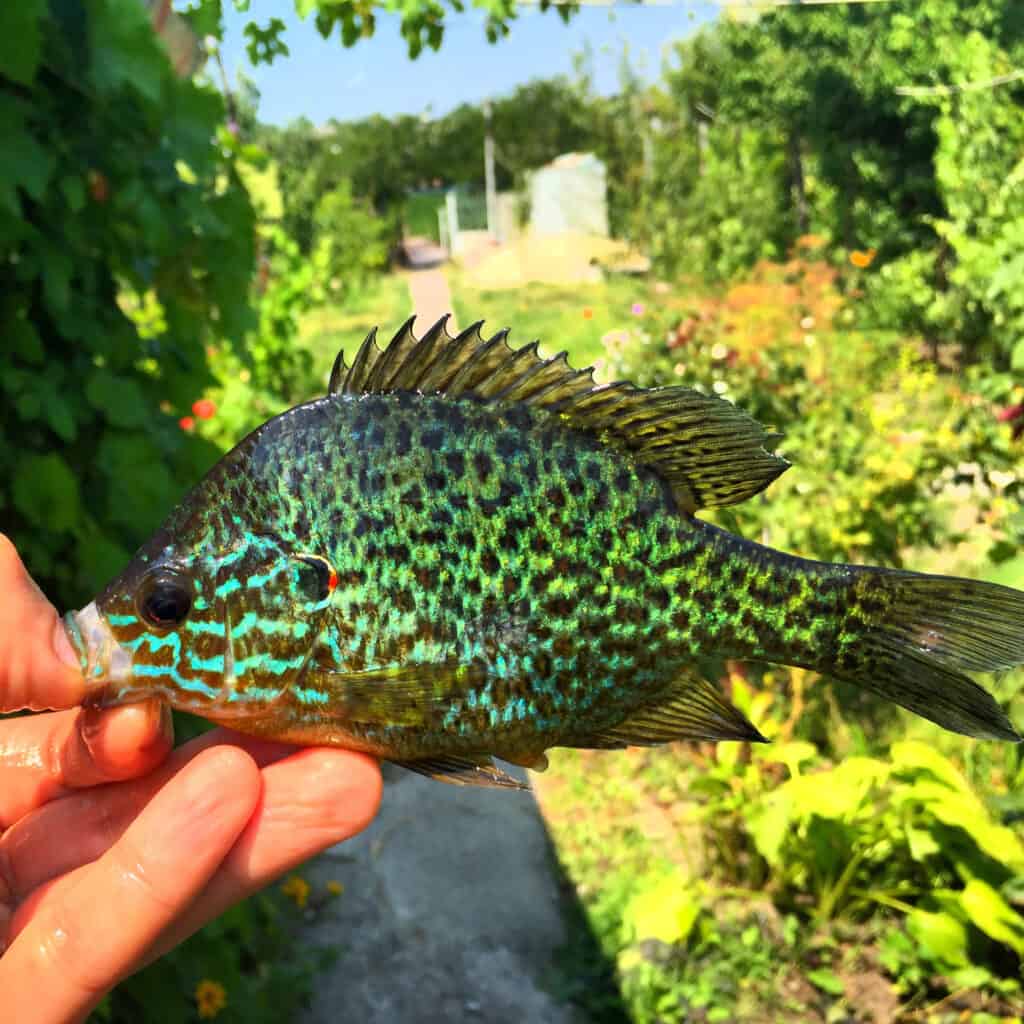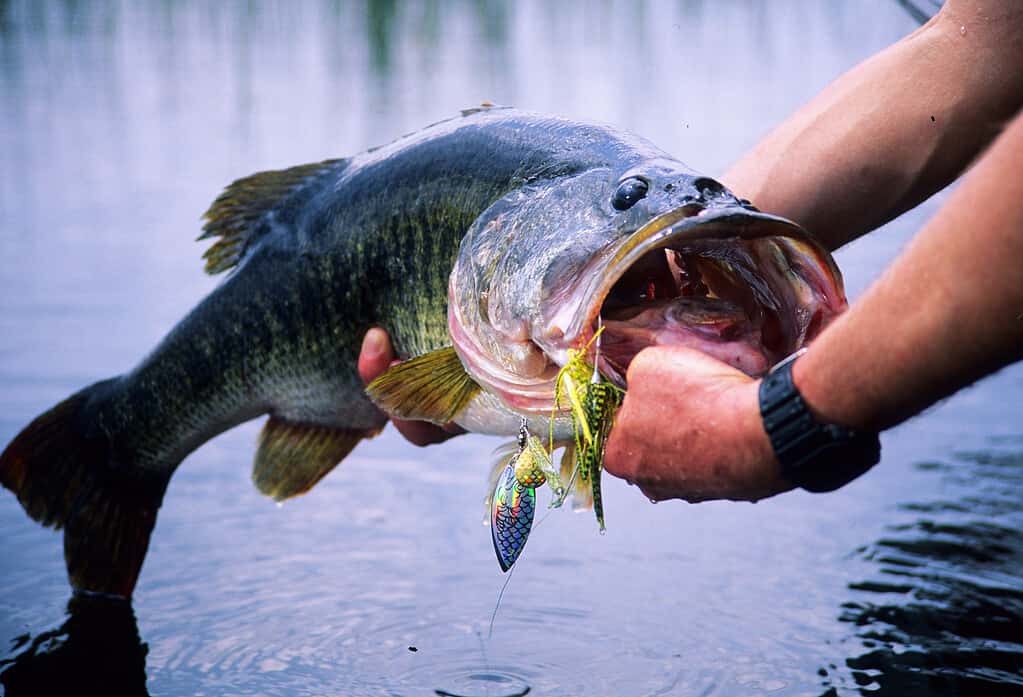Longnose gars are unique-looking large fish. They are abundant in Michigan. According to Michigan State University, the best time to fish for gar is during the summer. These long fish remain close to the surface of the water and frequently come up for air, making them easy to spot. They are massive, with a maximum recorded size of 48 pounds and 1 ounce. How does this compare to Michigan’s record? Follow along to discover the largest longnose gar ever caught in Michigan.

What is the Largest Longnose Gar Ever Caught in Michigan?
The largest longnose gar ever caught in Michigan was 53 inches long. The state-record-holding angler caught this impressive 18-pound longnose gar using a Green Rattle Trap in 1995. They caught this large prehistoric wonder in Williamsville Lake. This hidden gem is a 75-acre lake in Livingston County.

Longnose gar populations in Louisiana face habitat loss, overfishing, invasive species, and pollution threats.
©Mikhail Blajenov/Shutterstock.com
About Longnose Gar
Longnose gars are unique fish. They have a long history. These fish are members of the Lepisosteidae family. Although longnose gars were hunted by Native Americans, they were first recorded/described in 1758. Carl Linnaeus named these fish Esox osseus. Gars are primitive bony fish. They resemble their early ancestors and have highly vascularized swim bladder lungs. They’ve existed for millions of years.
Appearance and Size
Longnose gars are easy to distinguish from other fish in their environments. They have long torpedo-like bodies and long, but slender snouts (‘noses’). Longnose gars are also thick and strong. They have armor-like scales, which they use to defend themselves from predators. Longnose gars also have many tiny, but sharp teeth. They range in color but are typically green, brown, and silver. Interestingly, the color of a longnose gar depends on its environment, specifically the clarity of the water. Longnose gars in murky and dark water are generally more brown, while those in clearer waters are brighter green. They also have spots on most of their bodies, except their heads.
Longnose gars are interesting to look at, but their size is what makes them stand out from other fish. These long fish are about 2 to 4 feet long but can grow as long as 6 feet. They are also heavy. The longnose gar has a maximum weight of 55 pounds.

Longnose gars are about 2 to 4 feet long, although some can reach as long as 6 feet.
©SunnyChinchilla/Shutterstock.com
Habitat and Distribution
So, where do these fish live? Longnose gars are native to large parts of the eastern United States. They range from Central Florida up the Eastern Seaboard to the St Lawrence River in Quebec. These old fish also live in all the Great Lakes, except for Lake Superior. Although now only found in North America, longnose gar fossils have been discovered all over the world, including Asia, Africa, and Europe. Longnose gars have stable populations, although slightly declining. They are threatened by overfishing, habitat loss, and invasive species. Longnose gars mainly live in slow-moving streams, rivers, or lakes. They are sometimes found in large groups floating near the surface of the water. Young longnose gar though spend most of their time hunting and hiding in vegetation.
Diet
These slender fish mainly eat small fish and aquatic insects. The size of their prey depends on the age of the longnose gar. For instance, juvenile longnose gars eat small fish like inland silversides and small crustaceans. However, mature longnose gars have a larger diet. They eat bigger fish like bullhead catfish and sunfish. Longnose gars are ambush predators that strike from the side. They slowly move closer to prey and lunge quickly. Longnose gars typically hunt at night but sometimes eat during the day.
Predators
Longnose gars have few predators. Although they prefer floating near the surface, they are fast fish. Not only are longnose gars fast, but also tough to eat. Their scales aren’t easy to bite through. Few animals are curious or brave enough to pursue a longnose gar. The only potential natural predator of a longnose gar, aside from humans, is American alligators. However, not all longnose gar environments have alligators. Juvenile longnose gar though are vulnerable and are eaten by mammals like river otters, larger fish, and fish-eating birds.
Other Fish in Michigan
Longnose gars are fantastic fish to catch in Michigan, however, they aren’t your only choice. Keep reading to discover over fish species you may find in this state and the record for each.
Northern Hogsucker
The first fish on our list is the northern hogsucker. These small freshwater ray-finned fish are native to the United States and Canada. You can mainly find these fish in cold fast-moving springs, creeks, and rivers. Although vulnerable to pollution and dam construction, they are listed as Least Concern on the IUCN Red List with stable populations. Northern hogsuckers have wide diets. They also spend a lot of time at the bottom of rivers near rocks and stones. In Michigan, the largest northern hogsucker ever caught weighed 2.54 pounds. This state-record fish is 19 inches long. It was caught in the Saint Joseph River using a worm as bait.

Northern hogsuckers are native to Canada and the United States and live in clear and cold fast-moving rivers and streams.
Green Sunfish
Another fish in Michigan is the green sunfish. It’s a stocky and wide fish native to most of North America. This lovely and vibrant fish is also sometimes kept in aquariums. Green sunfish are mainly blue-green but also have yellow-flecked bony-ridged scales. They are also known for having bright blue stripes on the side of their heads. Green sunfish are small, only about 3 to 7 inches long. They also weigh around 1 pound or less. So, how does the largest sunfish caught in Michigan compare? The state-record green sunfish was 10 inches long and weighed 1.53 pounds. The angler caught this fish in Kirkwood Lake in 1990.

While the Green Sunfish is small, they are highly aggressive and predatory.
©Pocket Draw/Shutterstock.com
Black Buffalo
The next fish on our list is the black buffalo, a freshwater fish in the sucker family. It’s abundant and listed as Least Concern on the IUCN Red List. This lovely fish can live for about 56 years. They are most common in rivers in Canada and the United States. You can also find these fish in Mississippi, Texas, Minnesota, Oklahoma, Missouri, and Ohio. The average length of a black buffalo fish is 20 to 30 inches, but the world record catch was 48.5 inches long. The largest black buffalo caught in Michigan weighed 54.3 pounds and was 42.6 inches long, close to the world record.

Black buffalo fish are freshwater fish native to large parts of Canada and the United States.
©patrimonio designs ltd/Shutterstock.com
Largemouth Bass
Last but not least is one of the most common fish in the United States, the largemouth bass. These impressive bass, like other fish on this list, have a wide range. They are native to the eastern and central United States, southeastern Canada, and northern Mexico. Largemouth bass are also stocked in many lakes in the United States outside of their native range. These large fish can reach 29.5 inches long and weigh as much as 25 pounds. Females are slightly larger than male largemouth bass. These fish are highly sought after by anglers. They are fast swimmers and put up a fight. Largemouth bass are aggressive, and sometimes jump out of the water when hooked, attempting to get away.
Fun fact, There are two largemouth bass in Michigan state records. The first record was caught in 1934. The angler has held the record for the largest catch for about 90 years. The fish was caught in Big Pine Island Lake and is 11.94 pounds. About 25 years later, another largemouth bass of the same size was caught in the Alcona Dam Pond.

Largemouth bass can weigh as much as 25 pounds.
©iStock.com/stammphoto
The photo featured at the top of this post is © iStock.com/User10095428_393
Thank you for reading! Have some feedback for us? Contact the AZ Animals editorial team.







